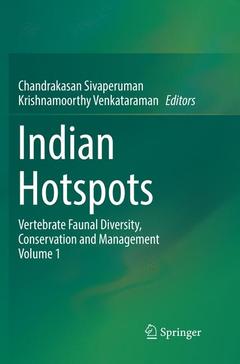Indian Hotspots, 1st ed. 2018 Vertebrate Faunal Diversity, Conservation and Management Volume 1
Coordonnateurs : Sivaperuman Chandrakasan, Venkataraman Krishnamoorthy

This book offers a comprehensive account of India?s four biodiversity hotspots: the Himalaya, Indo-Burma, Western Ghats and Sri Lanka and Andaman and Nicobar Islands. With a focus on tropical rainforests, it includes more than 30 chapters covering different vertebrate fauna e.g. fishes, amphibians, reptiles, birds, and mammals, as well as topics such as conservation and management aspects.
Written by experts in the field of biodiversity conservation and management, it offers ample new insights into a number of subjects related to the faunal communities of tropical forest ecosystems, providing a valuable resource for conservationists and researchers in the field of flora and fauna diversity.
Dr. C. Sivaperuman
Dr. C. Sivaperuman, is currently a Scientist-D at the Zoological Survey of India, Port Blair. He received his master’s degree in wildlife biology from Bharathidasan University, Tamil Nadu, and his doctorate degree in ecology of wetland birds in the Vembanad-Kole Ramsar site from the Kerala Forest Research Institute, Kerala, and Forest Research Institute, Deemed University, Dehra Dun. He has been extensively involved in field surveys in different parts of the country. He has published more than 200 research papers in national and international journals and newsletters. He also authored/edited more than 25 books published by respected national and international publishers. He has participated in 36th Indian Scientific Expedition to Antarctica during 2016-2017 and carried out studies on the species abundance and distribution of birds and mammals in Antarctica. He has participated and presented research papers at 60 national and international seminars and symposia. He is life member of various scientific societies in India and abroad.
Dr. K. Venkataraman
Dr. Krishnamoorthy Venkataraman, former Director Zoological Survey of India, is presently working as a senior Scientific Consultant at the National Centre for Sustainable Coastal Management, Anna University, Chennai.
His research areas include coastal and marine biodiversity assessment, coral reef restoration, integrated management of coastal, marine and wetland ecosystems, biodiversity laws and policies. He is an expert on strategy formulation, climate change resilience in management of marine ecosystem, meiofaunal assemblage in Antarctic ecosystem, and training and organizing awareness programmes on faunal resources conservation. He has 37 years of research experience in faunal diversity studies, and has served at Madurai Kamaraj University, Bombay Natural History Society (BNHS), National Biodiversity Authority, Loss o
Date de parution : 01-2019
Ouvrage de 397 p.
15.5x23.5 cm
Date de parution : 02-2018
Ouvrage de 397 p.
15.5x23.5 cm
Thèmes d’Indian Hotspots :
Mots-clés :
Ecology; Vertebrate; Diversity; Tropical Forests; Environmental Sciences



